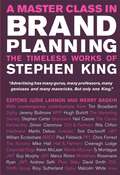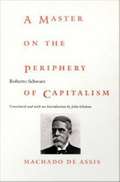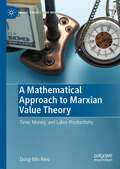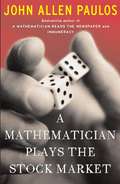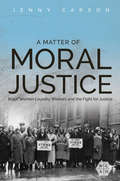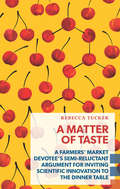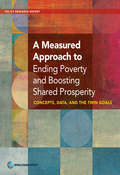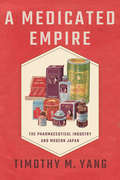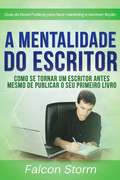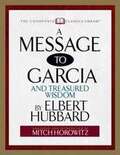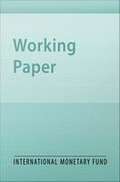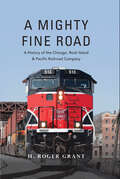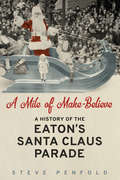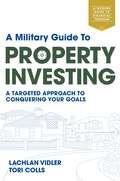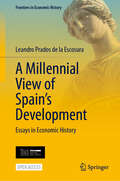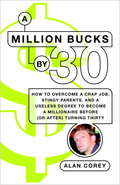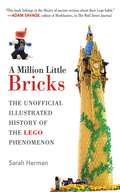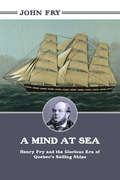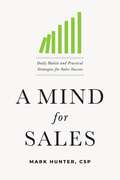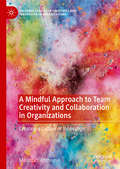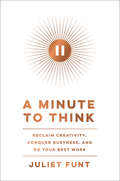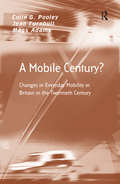- Table View
- List View
A Master Class in Brand Planning
by Judie Lannon Merry BaskinIn 1988, on Stephen King's retirement JWT published 'The King Papers' a small collection of Stephen King's published writings spanning 1967-1985. They remain timelessly potentially valuable but are an almost unexploited gold mine. This book is comprised of a selection of 20-25 of Stephen King's most important articles, each one introduced by a known and respected practitioner who, in turn, describes the relevance of the particular original idea to the communications environment of today.The worth of this material is that, although the context in which the original papers were written is different, the principles themselves are appropriate to marketing communications in today's more complex media environment. The book will serve as a valuable reference book for today's practitioners, as well as a unique source of sophisticated, contemporary thinking.
A Master on the Periphery of Capitalism: Machado De Assis
by Roberto SchwarzA Master on the Periphery of Capitalism is a translation (from the original Portuguese) of Roberto Schwarz's renowned study of the work of Brazilian novelist Machado de Assis (1839-1908). A leading Brazilian theorist and author of the highly influential notion of "misplaced ideas," Schwarz focuses his literary and cultural analysis on Machado's The Posthumous Memoirs of Brás Cubas, which was published in 1880. Writing in the Marxist tradition, Schwarz investigates in particular how social structure gets internalized as literary form, arguing that Machado's style replicates and reveals the deeply embedded class divisions of nineteenth-century Brazil. Widely acknowledged as the most important novelist to have written in Latin America before 1940, Machado had a surprisingly modern style. Schwarz notes that the unprecedented wit, sarcasm, structural inventiveness, and mercurial changes of tone and subject matter found in The Posthumous Memoirs of Brás Cubas marked a crucial moment in the history of Latin American literature. He argues that Machado's vanguard narrative reflects the Brazilian owner class and its peculiar status in both national and international contexts, and shows why this novel's success was no accident. The author was able to confront some of the most prestigious ideologies of the nineteenth century with some uncomfortable truths, not the least of which was that slavery remained the basis of the Brazilian economy. A Master on the Periphery of Capitalism will appeal to those with interests in Latin American literature, nineteenth century history, and Marxist literary theory.
A Masterpiece of Revenge: A Mystery
by J. J. FiechterFrom the author of comes a wickedly ingenious psychological thriller involving a priceless painting and a murderous plot to use it for revenge. Gripping from first page to last, A MASTERPIECE OF REVENGE is a classic Hitchcockian thriller that will keep the reader guessing every step of the way.
A Mathematical Approach to Marxian Value Theory: Time, Money, and Labor Productivity (Marx, Engels, and Marxisms)
by Dong-Min RieuThis book clarifies the quantitative relationship between time, money, and labor productivity from the perspective of Marxian labor theory of value. The book is divided into four main parts. Part I introduces the relationship between time and money in the context of Marxian value theory. Part II explores the theory of labor exploitation. Part III turns to analysis of the rate of profit, which is a primary characteristic of classical and Marxian economics. Part IV is devoted to suggesting a new research direction in light of the main conceptual innovation of the book.
A Mathematical Look at Politics
by E. Arthur Robinson Jr. Daniel H. UllmanWhat Ralph Nader's spoiler role in the 2000 presidential election tells us about the American political system. Why Montana went to court to switch the 1990 apportionment to Dean's method. How the US tried to use game theory to win the Cold War, and why it didn't work. When students realize that mathematical thinking can address these sorts of pres
A Mathematician Plays The Stock Market
by John Allen PaulosIn A Mathematician Plays the Stock Market best-selling author John Allen Paulos demonstrates what the tools of mathematics can tell us about the vagaries of the stock market. Employing his trademark stories, vignettes, paradoxes, and puzzles (and even a film treatment), Paulos addresses every thinking reader's curiosity about the market: Is it efficient? Is it rational? Is there anything to technical analysis, fundamental analysis, and other supposedly time-tested methods of picking stocks? How can one quantify risk? What are the most common scams? What light do fractals, network theory, and common psychological foibles shed on investor behavior? Are there any approaches to investing that truly outperform the major indexes? Can a deeper knowledge of mathematics help beat the odds?All of these questions are explored with the engaging erudition that made Paulos's A Mathematician Reads the Newspaper and Innumeracy favorites with both armchair mathematicians and readers who want to think like them. Paulos also shares the cautionary tale of his own long and disastrous love affair with WorldCom. In the tradition of Burton Malkiel's A Random Walk Down Wall Street and Jeremy Siegel's Stocks for the Long Run, this wry and illuminating book is for anyone, investor or not, who follows the markets-or knows someone who does.
A Matter of Moral Justice: Black Women Laundry Workers and the Fight for Justice (Working Class in American History #1)
by Jenny CarsonA long-overlooked group of workers and their battle for rights and dignity Like thousands of African American women, Charlotte Adelmond and Dollie Robinson worked in New York’s power laundry industry in the 1930s. Jenny Carson tells the story of how substandard working conditions, racial and gender discrimination, and poor pay drove them to help unionize the city’s laundry workers. Laundry work opened a door for African American women to enter industry, and their numbers allowed women like Adelmond and Robinson to join the vanguard of a successful unionization effort. But an affiliation with the powerful Congress of Industrial Organizations (CIO) transformed the union from a radical, community-based institution into a bureaucratic organization led by men. It also launched a difficult battle to secure economic and social justice for the mostly women and people of color in the plants. As Carson shows, this local struggle highlighted how race and gender shaped worker conditions, labor organizing, and union politics across the country in the twentieth century. Meticulous and engaging, A Matter of Moral Justice examines the role of African American and radical women activists and their collisions with labor organizing and union politics.
A Matter of Taste: A Farmers' Market Devotee's Semi-Reluctant Argument for Inviting Scientific Innovation to the Dinner Table (Exploded Views)
by Rebecca TuckerHow did farmer's markets, nose-to-tail, locavorism, organic eating, CSAs, whole foods, and Whole Foods become synonymous with “good food”? And are these practices really producing food that is morally, environmentally, or economically sustainable? Rebecca Tucker's compelling, reported argument shows that we must work to undo the moral coding that we use to interpret how we come by what we put on our plates. She investigates not only the danger of the accepted rhetoric, but the innovative work happening on farms and university campuses to create a future where nutritious food is climate-change resilient, hardy enough to grow season after season, and, most importantly, available to all—not just those willing or able to fork over the small fortune required for a perfect heirloom tomato. Tucker argues that arriving at that future will require a broad cognitive shift away from the idea that farmer's markets, community gardens, and organic food production is the only sustainable way forward; more than that, it will require the commitment of research firms, governments, corporations, and postsecondary institutions to develop and implement agriscience innovations that do more than improve the bottom line. A Matter of Taste asks us to rethink what good food really is.
A Measured Approach to Ending Poverty and Boosting Shared Prosperity
by World BankIn 2013, the World Bank Group adopted two new goals to guide its work: ending extreme poverty and boosting shared prosperity. More specifically, the goals are to reduce extreme poverty in the world to less than 3 percent by 2030, and to foster income growth of the bottom 40 percent of the population in each country. While poverty reduction has been a mainstay of the World Bank's mission for decades, the Bank has now set a specific goal and timetable, and for the first time, the Bank has explicitly included a goal linked to ensuring that growth is shared by all. The discussion until now has centered primarily on articulating the new goals. This report, the latest in World Bank's Policy Research Report series, goes beyond that and lays out their conceptual underpinnings, discusses their relative strengths and weaknesses by contrasting them with alternative indicators, and proposes empirical approaches and requirements to track progress towards the goals. The report makes clear that the challenges posed by the World Bank Group's new stance extend not just to the pursuit of these goals but, indeed, to their very definition and empirical content. The report also argues that an improved data infrastructure, consisting of many elements including the collection of more and better survey data, is critical to ensure that progress towards these goals can be measured, and policies to help achieve them can be identified and prioritized.
A Medicated Empire: The Pharmaceutical Industry and Modern Japan (Studies of the Weatherhead East Asian Institute, Columbia University)
by Timothy M. YangIn A Medicated Empire, Timothy M. Yang explores the history of Japan's pharmaceutical industry in the early twentieth century through a close account of Hoshi Pharmaceuticals, one of East Asia's most influential drug companies from the late 1910s through the early 1950s. Focusing on Hoshi's connections to Japan's emerging nation-state and empire, and on the ways in which it embraced an ideology of modern medicine as a humanitarian endeavor for greater social good, Yang shows how the industry promoted a hygienic, middle-class culture that was part of Japan's national development and imperial expansion. Yang makes clear that the company's fortunes had less to do with scientific breakthroughs and medical innovations than with Japan's web of social, political, and economic relations. He lays bare Hoshi's business strategies and its connections with politicians and bureaucrats, and he describes how public health authorities dismissed many of its products as placebos at best and poisons at worst. Hoshi, like other pharmaceutical companies of the time, depended on resources and markets opened up, often violently, through colonization. Combining global histories of business, medicine, and imperialism, A Medicated Empire shows how the development of the pharmaceutical industry simultaneously supported and subverted regimes of public health at home and abroad.
A Mentalidade do Escritor
by Falcon Storm Gabriel Martimiano PiresA Mentalidade Do Escritor por Falcon Storm Tornar-se um escritor é simples como ajustar a sua mentalidade e mudar as habilidades que você já tem, saiba o que você precisa para alcançar o seu sonho hoje. Você sente que o seu propósito de vida é ser um escritor e compartilhar histórias da sua cabeça com o resto do mundo? Você almeja escrever o novo romance de grande sucesso? Talvez já tenha escrito alguns livros, mas quer levar os esforços de produtividade, talento e marketing a outros patamares, talvez já tenha começado como um escritor e se sentiu perdido nas várias tarefas que esperam por você, talvez esteja parado no primeiro quadrado, sem ter ideia do que fazer, aonde ir, até mesmo se deve escrever. A Mentalidade do Escritor está aqui para lhe ajudar! Em poucas horas, você vai aprender o básico para ser um escritor profissional, você vai aprender mais do que colocar palavras no papel, você vai aprender como entrar na mentalidade de um escritor e ficar lá, cavando o seu nicho no mundo literário, com esse guia, você vai aprender também: Descubra a diferença entre escritores e todos os outros Colocar metas específicas e atingíveis para a sua carreira Trabalhar com o tempo de forma eficaz Melhorar a habilidade de escrita Criar um produto profissional Alavancar a sua marca de escritor Construir um site de escritor Identificar o que fazer e o que não fazer nas redes sociais Tornar-se parte de uma comunidade online de escritores ou leitores Comece como um escritor profissional HOJE Oferecemos 5 brindes exclusivos para os leitores desse livro! A Nossa Garantia: Está cansado de livros para fazer marketing de livros que focam mais na história de vida do escritor do que em conselhos que você pode usar na sua carreira? Ou, pior ainda, guias de conselhos que são direcionados para escritos de não-ficção e têm poucas informações úteis para romancistas?
A Message to Garcia: And Treasured Wisdom
by Mitch Horowitz Elbert HubbardHistory's Greatest Motivational Lesson: Now in a Definitive Edition with Gems of Wisdom from Elbert HubbardThis remarkably concise, powerful statement on what makes a person successful remains as relevant today as when it was written more than a century ago. If you take seriously the principle of Elbert Hubbard's A Message to Garcia, you will become the indispensible, productive, successful, and respected person you have always wished to be. All that is required is for you to "carry a message to Garcia" - which means to do a job simply as it should be done. Discover for yourself the incredible power hidden in this one step. This edition of A Message to Garcia surpasses other volumes because it includes short passages of life-advice from Hubbard, which elucidate his message and demonstrate how to put it into action.Selected and introduced by PEN Award-winning historian Mitch Horowitz, this slender volume offers a life-changing journey into a single idea that can make all the difference in your earning power, effectiveness, and success. The Condensed Classics Library"40 Minutes to a New You"
A Method for Calculating Export Supply and Import Demand Elasticities
by Stephen TokarickA report from the International Monetary Fund.
A Mighty Fine Road: A History of the Chicago, Rock Island & Pacific Railroad Company
by H. Roger Grant“Grant has once again hit a home run . . . a detailed but readable history of the Chicago, Rock Island and Pacific, a major Midwestern railroad.” —Carlos A. Schwantes, St. Louis Mercantile Library Professor EmeritusThe Chicago, Rock Island & Pacific Railroad’s history is one of big booms and bigger busts. When it became the first railroad to reach and then cross the Mississippi River in 1856, it emerged as a leading American railroad company. But after aggressive expansion and a subsequent change in management, the company struggled and eventually declared bankruptcy in 1915. What followed was a cycle of resurrections and bankruptcies; a grueling, ten-year, ultimately unsuccessful battle to merge with the Union Pacific; and the Rock Island’s final liquidation in 1981. But today, long after its glory days and eventual demise, the “Mighty Fine Road” has left behind a living legacy of major and feeder lines throughout the country. In his latest work, railroad historian H. Roger Grant offers an accessible, gorgeously illustrated, and comprehensive history of this iconic American railroad.“This handsome, well-illustrated book merits the attention of any reader interested in the history of Iowa. And just as important, the book reminds us of the importance of railroads to the history and vitality of American society. All aboard!” —Iowa City Press-Citizen“A Mighty Fine Road lays out the amazing, yet heartbreaking history of the railroad I loved. The historical opportunities and disappointments of the Rock Island is clearly explained in Grant’s book, with visionaries keeping the dream moving forward, yet damaged and constrained by greed and lack of vision with the next management regime.” —Dan Sabin, President, Iowa Northern Railway Company
A Migrant Family
by Larry Dane BrimnerWe all know what a supermarket is, but what is a farmer's market? It's a place where people gather together to sell products -- such as flowers, herbs, vegetables, fruit, and more -- that they have grown or produced. Through lively text, readers will meet two families -- one Hmong American and the other German American -- as they work hard to prepare for a busy market season.
A Mile of Make-Believe: A History of the Eaton's Santa Claus Parade
by Steve PenfoldA Mile of Make Believe examines the unique history of the Santa Claus parade in Canada. This volume focuses on the Eaton's sponsored parades that occurred in Toronto, Montreal and Winnipeg as well as the shorter-lived parades in Calgary and Edmonton. There is also a discussion of small town alternatives, organized by civic groups, service clubs, and chambers of commerce. By focusing on the pioneering effort of the Eaton's department store Steve Penfold argues that the parade ultimately represented a paradoxical form of cultural power: it allowed Eaton's to press its image onto public life while also reflecting the decline of the once powerful retailer. Penfold's analysis reveals the "corporate fantastic" - a visual and narrative mix of meticulous organization and whimsical style- and its influence on parade traditions. Steve Penfold's considerable analytical skills have produced a work that is simultaneously a cultural history, history of business and commentary on consumerism. Professional historians and the general public alike would be remiss if this wasn't on their holiday wish list.
A Military Guide to Property Investing: A targeted approach to conquering your goals
by Lachlan Vidler Tori CollsA 10-step guide to achieving financial freedom through property investing. Property investing has long been recognised as one of the most successful long-term wealth creation strategies. With interest rates at all-time lows, it looks set to continue to be so. There are so many approaches to property investing, it's no wonder people struggle to understand the fundamentals that drive success in property. This comprehensive, easy-to-understand guide aims to educate readers on how they can begin their own property investment journey with ruthless military precision and efficiency. Written by two former military professionals, Lachlan Vidler and Tori Colls, A Military Guide to Property Investing presents the step-by-step method they followed to amass an impressive portfolio of properties while still in their twenties. Based on the military principles of strategy, discipline and execution, it offers a fail-safe plan to take control of your financial destiny.
A Millennial View of Spain’s Development: Essays in Economic History (Frontiers in Economic History)
by Leandro Prados de la EscosuraThis open access book presents the evolution of the Spanish economy over the past seven centuries since the end of the Reconquest and examines how much economic progress has Spain achieved, as well as its impact on living standards and income distribution over the very long run. It shows that preindustrial Spain was far from stagnant, although levels of output per head in the early nineteenth century were not much different from those on the eve of the Black Death (1348). It further discusses how phases of simultaneous per capita output and population expansion and shrinkage alternated, lending support to the recurring growth and frontier economy hypotheses. While a collapse in the 1570s gave way to sluggish growth and higher inequality after a long phase of sustained growth and lower inequality, the book shows how real per capita income has improved substantially over the last two centuries, driven by increased labor productivity, and derived from more intense andefficient use of physical and human capital per worker. Presenting exposure to international competition as a stimulus for this development, the book sheds light on the underperformance of Spain up to 1950 in a European comparison and describes the catch-up of Spain’s economy with more advanced countries until 2007. Finally, the book explains how modern economic growth is associated with an increase in the material well-being of its inhabitants, as the most dynamic economic phases of the last century have been associated with an improvement in income distribution, although the relationship between growth and inequality has not been linear. This book is a must-read for students, researchers, and scholars of economics and economic history interested in a better understanding of cliometrics, long-run analyses, economic development, economic growth, as well as the Spanish economy.
A Million Bucks by 30
by Alan CoreyAt twenty-two, Alan Corey left his mom's basement in Atlanta and moved to New York City with one goal in mind: to become a millionaire by the time he was thirty. His parents and friends laughed, but six years later they were all celebrating his prosperous accomplishment-at a bar Corey owned in one of Brooklyn's hippest neighborhoods.No, Corey didn't climb the corporate ladder to build his fortune. In fact, he worked the same entry-level 9-to-5 job for six years straight. But by pinching his pennies and making sound investments, he watched a pittance blossom into a seven-digit bank account. In A Million Bucks by 30, Corey recounts his rags-to-riches journey and shares his secrets to success. WARNING: DO NOT ATTEMPT TO USE THIS BOOK UNLESS YOU ARE PREPARED TO BECOME FILTHY RICH."What a steal . . . For any entrepreneur the advice in these pages is worth more than a million bucks."-Barbara Corcoran, founder, The Corcoran Group"This is the best personal finance book I've ever read. Part self-help, part brass-tacks money guide; Corey's confessional tales of making it to the million dollar mark are as hilarious as they are helpful."-John Reynolds, writer, The Late Late Show with Craig FergusonFrom the Trade Paperback edition.
A Million Little Bricks: The Unofficial Illustrated History of the LEGO Phenomenon
by Sarah HermanToy of the Year, Toy of the Century, Greatest Toy of All Time . . . there aren't many titles that haven't been bestowed on LEGO toys, and it's not hard to see why. From its inception in the early 1930s right up until today, the LEGO Group's history is as colorful as the toys it makes. Few other playthings share the LEGO brand's creative spirit, educative benefits, resilience, quality, and universal appeal. The LEGO name is now synonymous with playtime, but it wasn't always so. This history charts the birth of the LEGO Group in the workshop of a Danish carpenter and its steady growth as a small, family-run toy manufacturer to its current position as a market-leading, award-winning brand. The company's ever-increasing catalogof products-including the earliest wooden toys, plastic bricks, play themes, and other building systems such as DUPLO, Technic, and MINDSTORMS-are chronicled in detail, alongside the manufacturing process, LEGOLAND parks, licensed toys, and computer games. Learn all about how LEGO pulled itself out of an economic crisis and embraced technology to make building blocks relevant to twenty-first-century children and discover the vibrant fan community of kids and adults whose conventions, websites, and artwork keep the LEGO spirit alive. As nostalgic as it is contemporary, A Million Little Bricks will have you reminiscing about old Classic Space sets, rummaging through the attic for forgotten Minifigure friends, and playing with whatever LEGO bricks you can get your hands on (even if it means sharing with your kids).
A Mind at Sea: Henry Fry and the Glorious Era of Quebec's Sailing Ships
by John FryThe trials and tribulations of a Canadian business titan during a fascinating period in 19th-century Quebec. A Mind at Sea is an intimate window into a vanished time when Canada was among the world’s great maritime countries. Between 1856 and 1877, Henry Fry was the Lloyd’s agent for the St. Lawrence River, east of Montreal. The harbour coves below his home in Quebec were crammed with immense rafts of cut wood, the river’s shoreline sprawled with yards where giant square-rigged ships – many owned by Fry – were built. As the president of Canada’s Dominion Board of Trade, Fry was at the epicentre of wealth and influence. His home city of Quebec served as the capital of the province of Canada, while its port was often the scene of raw criminality. He fought vigorously against the kidnapping of sailors and the dangerous practice of deck loading. He also battled against and overcame his personal demon – mental depression – going on to write many ship histories and essays on U.S.-Canada relations. Fry was a colourful figure and a reformer who interacted with the famous figures of the day, including Lord and Lady Dufferin, Sir John A. Macdonald, Wilfrid Laurier, and Sir Narcisse-Fortunat Belleau, Quebec’s lieutenant-governor.
A Mind for Sales: Daily Habits and Practical Strategies for Sales Success
by Mark Hunter, CSPFor salespeople feeling stressed and disappointed that their customers don&’t want to hear from them, this guide is the key to developing the mindset and habits required to reach a new level of sales success.The world of sales can be tough, so it&’s easy to get discouraged when the rejections start piling up and your customers stop answering the phone. This allows the wrong thought patterns to start developing, soon you aren&’t making quotas and then you begin looking at job listings waiting for your next downfall.Sales expert Mark Hunter can relate as his start to sales was discouraging. The lessons he&’s learned throughout his career are revealed in A Mind for Sales. He discovered that sales can be incredibly rewarding, such as customers calling you for advice, thanking you for improving their business, and referring you to colleagues. The difference is simply developing mindset and momentum habits.In A Mind for Sales, you&’ll learn how to:Feel energized by renewed purpose and success in your sales role by following the success cycle approach.Receive practical strategies on how to change your mindset and succeed in sales.Learn the daily habits needed to maximize productivity and make hitting the ground running strategy #1.Gain real-world insights from Hunter&’s vast experience as a successful sales professional and sales coach.Let this book inspire and prepare you to form the new habits you need to succeed and to realize the incredible rewards that a successful life in sales makes possible.
A Mindful Approach to Team Creativity and Collaboration in Organizations: Creating a Culture of Innovation (Palgrave Studies in Creativity and Innovation in Organizations)
by Melinda J. RothouseThis book examines how contemplative arts practice and a mindful approach to creativity, can be used to offer new possibilities for facilitating team creativity and collaboration in organizational settings. The author employs a qualitative, action research paradigm, using arts‐based and ethnographic methods, to explore the perceived effects of a contemplative arts workshop process on team creativity and collaboration within an organization. The book demonstrates how a contemplative arts workshop process may be used to facilitate mindfulness, trust, communication, collaboration, and creative insights among teams and working groups. It explores each of these themes in depth and develops a model based on those findings. The model includes five elements: 1. Individual-Level Mindfulness, 2. Trust and Authentic Communication, 3. Team Cohesion and Collaboration, 4. Creative Ideation and Insights, and 5. Leadership: Creating a Culture of Innovation. Combining theory and practice, the book offers a series of mindfulness and contemplative arts exercises that facilitators can use to address each of the five levels of the model. This book weaves together contemporary psychological research on mindfulness and organizational creativity along with practical applications and contemplative arts exercises for practitioners and scholars of workplace creativity, management and organisational and industrial psychology.
A Minute to Think: Reclaim Creativity, Conquer Busyness, and Do Your Best Work
by Juliet Funt“You’re going to want to share copies of this book with your overbooked friends and colleagues, but before you do, take some time to read it yourself. Funt’s wisdom around making space is priceless.” —Seth Godin, author of The PracticeDo you wish you could stop the mayhem of work and life and just take a minute? Do you sense you could contribute more if there were a little more room in the day? Does busyness deprive you and your burnt-out team of the oxygen your talents need to catch fire?Many have felt that way, yet taking a pause has seemed impossible—until now.In A Minute to Think, Juliet Funt, a globally recognized warrior in the battle against busyness, provides a powerful guide that will give you the permission, framework, and specific direction you need to do the following:Regain control of your overloaded, caffeinated, inbox-worshiping workdayLiberate yourself and your teams from burnout and busyworkReclaim creativity and focus despite the chaos around youBring thoughtfulness into designing your next work normsTame the beast of email and escape the mire of meetingsFind your precious minute to thinkYou’re not alone in your yearning for freedom from constant reactivity. The global workforce today is so fried that it belongs in the food court of a county fair. We’re relentlessly behind the curve, dousing fires everywhere, and our 3 a.m. insomnia provides the only unscheduled thinking time of the day.What we need reinserted in our lives is the missing element of white space—short periods of open, unscheduled time that, when recaptured, change the very nature of work. White space is the stepping back, the strategic pause, the oxygen that allows the sparks of our efforts to catch fire. White space has the power to radically—and simply—reinvent the way we approach work in this maxed-out, post-COVID 21st-century world.With Juliet’s memorable stories, easy-to-use tools, and razor-sharp instruction, she carves for us an escape route from the overwhelming amount of low-value tasks and the daily avalanche of e-mails, meetings, decks, and reports. Using research, client stories, and a relatable voice, Juliet shows all of us how to reclaim time for thinking and make room for what truly matters. Whether you are an individual trying to build a more sane and humane flow of daily work, a team that wants new levels of efficiency and effectiveness, or an entire organization changing your culture toward thoughtfulness, this book will lead you there.
A Mobile Century?: Changes in Everyday Mobility in Britain in the Twentieth Century (Transport and Mobility)
by Colin G. Pooley Jean Turnbull Mags AdamsFor most people in the developed world, the ability to travel freely on a daily basis is almost taken for granted. Although there is a large volume of literature on contemporary mobility and associated transport problems, there are no comprehensive studies of the ways in which these trends have changed over time. This book provides a detailed empirical analysis of mobility change in Britain over the twentieth century. Beginning with an explanatory theoretical overview, setting the UK case studies within an international context, the book then analyses changes in the journey to school, the journey to work, and travelling for pleasure. It also looks at the ways in which changes in mobility have interacted with changes in the family life cycle and assesses the impact of new transport technologies on everyday mobility. It concludes by examining the implications of past mobility change for contemporary transport policy.
